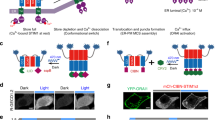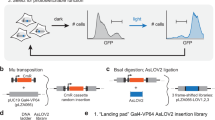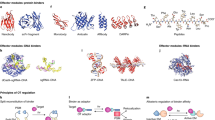Abstract
Genetically encodable optical reporters, such as green fluorescent protein, have revolutionized the observation and measurement of cellular states. However, the inverse challenge of using light to control precisely cellular behaviour has only recently begun to be addressed; semi-synthetic chromophore-tethered receptors1 and naturally occurring channel rhodopsins have been used to perturb directly neuronal networks2,3. The difficulty of engineering light-sensitive proteins remains a significant impediment to the optical control of most cell-biological processes. Here we demonstrate the use of a new genetically encoded light-control system based on an optimized, reversible protein–protein interaction from the phytochrome signalling network of Arabidopsis thaliana. Because protein–protein interactions are one of the most general currencies of cellular information, this system can, in principle, be generically used to control diverse functions. Here we show that this system can be used to translocate target proteins precisely and reversibly to the membrane with micrometre spatial resolution and at the second timescale. We show that light-gated translocation of the upstream activators of Rho-family GTPases, which control the actin cytoskeleton, can be used to precisely reshape and direct the cell morphology of mammalian cells. The light-gated protein–protein interaction that has been optimized here should be useful for the design of diverse light-programmable reagents, potentially enabling a new generation of perturbative, quantitative experiments in cell biology.
This is a preview of subscription content, access via your institution
Access options
Subscribe to this journal
Receive 51 print issues and online access
$199.00 per year
only $3.90 per issue
Buy this article
- Purchase on Springer Link
- Instant access to full article PDF
Prices may be subject to local taxes which are calculated during checkout




Similar content being viewed by others
References
Szobota, S. et al. Remote control of neuronal activity with a light-gated glutamate receptor. Neuron 54, 535–545 (2007)
Boyden, E. S., Zhang, F., Bamberg, E., Nagel, G. & Deisseroth, K. Millisecond-timescale, genetically targeted optical control of neural activity. Nature Neurosci. 8, 1263–1268 (2005)
Han, X. & Boyden, E. S. Multiple-color optical activation, silencing, and desynchronization of neural activity, with single-spike temporal resolution. PLoS One 2, e299 (2007)
Mettetal, J. T., Muzzey, D., Gómez-Uribe, C. & van Oudenaarden, A. The frequency dependence of osmo-adaptation in Saccharomyces cerevisiae . Science 319, 482–484 (2008)
Bennett, M. R. et al. Metabolic gene regulation in a dynamically changing environment. Nature 454, 1119–1122 (2008)
Ghosh, M. et al. Cofilin promotes actin polymerization and defines the direction of cell motility. Science 304, 743–746 (2004)
Gorostiza, P. & Isacoff, E. Y. Optical switches for remote and noninvasive control of cell signaling. Science 322, 395–399 (2008)
Levskaya, A. et al. Synthetic biology: engineering Escherichia coli to see light. Nature 438, 441–442 (2005)
Lee, J. et al. Surface sites for engineering allosteric control in proteins. Science 322, 438–442 (2008)
Shimizu-Sato, S., Huq, E., Tepperman, J. M. & Quail, P. H. A light-switchable gene promoter system. Nature Biotechnol. 20, 1041–1044 (2002)
Quail, P. H. Phytochrome photosensory signalling networks. Nature Rev. Mol. Cell Biol. 3, 85–93 (2002)
Ni, M., Tepperman, J. M. & Quail, P. H. Binding of phytochrome B to its nuclear signalling partner PIF3 is reversibly induced by light. Nature 400, 781–784 (1999)
Khanna, R. et al. A novel molecular recognition motif necessary for targeting photoactivated phytochrome signaling to specific basic helix-loop-helix transcription factors. Plant Cell 16, 3033–3044 (2004)
Tyszkiewicz, A. B. & Muir, T. W. Activation of protein splicing with light in yeast. Nature Methods 5, 303–305 (2008)
Leung, D. W., Otomo, C., Chory, J. & Rosen, M. K. Genetically encoded photoswitching of actin assembly through the Cdc42-WASP-Arp2/3 complex pathway. Proc. Natl Acad. Sci. USA 105, 12797–12802 (2008)
Su, Y. & Lagarias, J. C. Light-independent phytochrome signaling mediated by dominant GAF domain tyrosine mutants of Arabidopsis phytochromes in transgenic plants. Plant Cell 19, 2124–2139 (2007)
Heo, W. D. et al. PI(3,4,5)P3 and PI(4,5)P2 lipids target proteins with polybasic clusters to the plasma membrane. Science 314, 1458–1461 (2006)
Al-Sady, B., Ni, W., Kircher, S., Schäfer, E. & Quail, P. H. Photoactivated phytochrome induces rapid PIF3 phosphorylation prior to proteasome-mediated degradation. Mol. Cell 23, 439–446 (2006)
Genoud, T. et al. FHY1 mediates nuclear import of the light-activated phytochrome A photoreceptor. PLoS Genet. 4, e1000143 (2008)
Chen, M., Tao, Y., Lim, J., Shaw, A. & Chory, J. Regulation of phytochrome B nuclear localization through light-dependent unmasking of nuclear-localization signals. Curr. Biol. 15, 637–642 (2005)
Inoue, T., Heo, W. D., Grimley, J. S., Wandless, T. J. & Meyer, T. An inducible translocation strategy to rapidly activate and inhibit small GTPase signaling pathways. Nature Methods 2, 415–418 (2005)
Wang, S. et al. All optical interface for parallel, remote, and spatiotemporal control of neuronal activity. Nano Lett. 7, 3859–3863 (2007)
Castellano, F. et al. Inducible recruitment of Cdc42 or WASP to a cell-surface receptor triggers actin polymerization and filopodium formation. Curr. Biol. 9, 351–361 (1999)
Suh, B., Inoue, T., Meyer, T. & Hille, B. Rapid chemically induced changes of PtdIns(4,5)P2 gate KCNQ ion channels. Science 314, 1454–1457 (2006)
Inoue, T. & Meyer, T. Synthetic activation of endogenous PI3K and Rac identifies an AND-gate switch for cell polarization and migration. PLoS One 3, e3068 (2008)
Gambetta, G. A. & Lagarias, J. C. Genetic engineering of phytochrome biosynthesis in bacteria. Proc. Natl Acad. Sci. USA 98, 10566–10571 (2001)
Acknowledgements
We thank B. El-Sady, J. Tepperman, K. Thorn, G. Kapp and members of the Voigt, Weiner and Lim laboratories for assistance and discussion. We thank Molecular Devices and Photonics Instruments for the loan and customization of a Mosaic spatial light modulator. Data for this study were acquired at the Nikon Imaging Center at UCSF. This work was supported by a NSFGR fellowship (A.L.); NIH R01 GM084040 and Searles Scholar Award.(O.D.W.); Packard Fellowship, the Howard Hughes Medical Institute, and NIH grants GM55040, GM62583 and EY016546 (NIH Roadmap Nanomedicine Development Centers) (W.A.L.); Pew Fellowship, the Office of Naval Research, Packard Fellowship, NIH EY016546, NIH AI067699, NSF BES-0547637, UC-Discovery and the SynBERC NSF ERC (C.A.V.).
Author Contributions Concept was conceived by A.L., W.A.L. and C.A.V.; experiments were executed by A.L.; spatiotemporal microscopy methods were developed by A.L. and O.D.W.; all authors were involved in interpretation of results and preparation of the manuscript.
Author information
Authors and Affiliations
Corresponding author
Additional information
Plasmids will be available from Addgene (http://www.addgene.org).
Supplementary information
Supplementary Information
This file contains Supplementary Methods, Supplementary Table S1, Supplementary Data, Supplementary Movie Legends, Supplementary References and Supplementary Figures S1-S5 with Legends. (PDF 826 kb)
Supplementary Movie 1
This movie shows YFP membrane recruitment - see file s1 for full Legend. (MOV 246 kb)
Supplementary Movie 2
This movie shows YFP membrane dissociation - see file s1 for full Legend. (MOV 149 kb)
Supplementary Movie 3
This movie shows oscillating YFP translocation - see file s1 for full Legend. (MOV 1986 kb)
Supplementary Movie 4
This movie shows YFP point recruitment - see file s1 for full Legend. (MOV 185 kb)
Supplementary Movie 5
This movie shows patterned recruitment of YFP - see file s1 for full Legend. (MOV 583 kb)
Supplementary Movie 6
This movie shows titrated recruitment of YFP - see file s1 for full Legend. (MOV 755 kb)
Supplementary Movie 7
This movie shows cell extrusion by Tiam(Rac GEF) recruitment - see file s1 for full Legend. (MOV 764 kb)
Supplementary Movie 8
This movie shows dynamic lamellipodia by Tiam(Rac GEF - see file s1 for full Legend. (MOV 7019 kb)
Supplementary Movie 9
This movie shows periodic contractions by Tim(Rho GEF) recruitment - see file s1 for full Legend. (MOV 481 kb)
Supplementary Movie 10
This movie shows PIF-YFP only recruitment control - see file s1 for full Legend. (MOV 806 kb)
Supplementary Movie 11
This movie shows monitoring membrane-bound Cdc42-GTP dynamics via recruited mCherry-WASP-GBD in TIRF - see file s1 for full Legend. (MOV 4621 kb)
Rights and permissions
About this article
Cite this article
Levskaya, A., Weiner, O., Lim, W. et al. Spatiotemporal control of cell signalling using a light-switchable protein interaction. Nature 461, 997–1001 (2009). https://doi.org/10.1038/nature08446
Received:
Accepted:
Published:
Issue Date:
DOI: https://doi.org/10.1038/nature08446
Comments
By submitting a comment you agree to abide by our Terms and Community Guidelines. If you find something abusive or that does not comply with our terms or guidelines please flag it as inappropriate.



